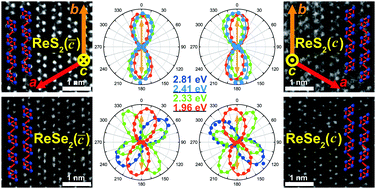Complete determination of the crystallographic orientation of ReX2 (X = S, Se) by polarized Raman spectroscopy†
Abstract
Polarized Raman spectroscopy on few-layer ReS2 and ReSe2 was carried out to determine the crystallographic orientations. Since monolayer ReX2 (X = S or Se) has a distorted trigonal structure with only an inversion center, there is in-plane anisotropy and the two faces of a monolayer crystal are not equivalent. Since many physical properties vary sensitively depending on the crystallographic orientation, it is important to develop a reliable method to determine the crystal axes of ReX2. By comparing the relative polarization dependences of some representative Raman modes measured with three different excitation laser energies with high-resolution scanning transmission electron microscopy, we established a reliable procedure to determine all three principal directions of few-layer ReX2, including a way to distinguish the two types of faces: a 2.41 eV laser for ReS2 or a 1.96 eV laser for ReSe2 should be chosen as the excitation source of polarized Raman measurements; then the relative directions of the maximum intensity polarization of the Raman modes at 151 and 212 cm−1 (124 and 161 cm−1) of ReS2 (ReSe2) can be used to determine the face types and the Re-chain direction unambiguously.

- This article is part of the themed collection: Nanoscale Horizons 2021 Lunar New Year Collection


 Please wait while we load your content...
Please wait while we load your content...